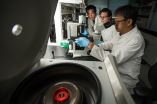(Press-News.org) DURHAM, N.C. -- Criminals are far more likely to acquire guns from family and acquaintances than by theft, according to new studies by researchers at Duke University and the University of Chicago.
"There are a number of myths about how criminals get their guns, such as most of them are stolen or come from dirty dealers. We didn't find that to be the case," said Philip J. Cook, a professor of public policy, economics and sociology at Duke's Sanford School of Public Policy.
One study asked inmates of the Cook County Jail in Chicago how they obtained guns, while a second project analyzed data that traced guns used in crimes. The gun trace requests were submitted to the federal Bureau of Alcohol, Tobacco, Firearms and Explosives (ATF) by the Chicago Police Department from 2009 to 2013.
Key findings from the studies include:
60 percent of the respondents obtained guns by purchase or trade.
Most offenders obtained guns from personal connections, not from gun stores or by theft.
Most of the guns were old (11 years old on average), and criminals held onto the guns a short time, frequently less than a year.
Chicago gangs sometimes organize gun buys and distribute guns to members.
The Chicago Police Department's enforcement efforts had an influence on the underground gun market. Respondents were concerned with the higher risk of arrest when dealing with a stranger and about being caught with a "dirty" gun that had been fired in a previous crime.
In 2013, for the Cook County Jail Pilot Survey, researchers interviewed 99 inmates with a record of violence and gang involvement about their gun purchases. Chicago gun laws prohibit selling guns to people with criminal records, or those under 21 years old.
The study, "Sources of Guns to Dangerous People: What we Learn by Asking Them," was published online by the journal Preventive Medicine and will appear in print next month in a special issue, "The Epidemiology and Prevention of Gun Violence." The research was supported by the Joyce Foundation.
"One survey respondent gave what amounted to a lecture on how guns enter the neighborhood," said Cook.
That respondent said, "As far as Chicago, it's so close to Indiana ... there's gun laws, but it's easier to get access to guns in Indiana so most people either go to the down-South states or go to Indiana to get guns or people obtain gun licenses, go to the store and then resell."
Information from the Cook County inmates lined up with findings in a second study, which identified straw purchasers and gun traffickers as key sources of crime guns in Chicago. Straw purchasers can pass a background check and buy guns that they transfer to others.
This study, "Some Sources of Crime Guns in Chicago: Dirty dealers, straw purchases and traffickers," is forthcoming in the 2015 Journal of Criminal Law and Criminology. The research was supported by operating grants to the University of Chicago from the MacArthur and McCormick foundations, as well as project grants from the Joyce and McCormick foundations and the Fund for a Safer Future.
By linking ATF information that traced guns t¬¬¬o crimes with information from the Chicago Police Department about the person caught with the gun, the researchers could identify which of them were gang members and compare their guns with those possessed by non-gang members.
"Dirty dealers," who deliberately violate the law and sell to buyers who cannot pass a background check, accounted for less than 5 percent of the guns sold to gang members.
More than 60 percent of the crime guns were initially purchased out of state. Meanwhile, 15 percent of new crime guns confiscated from a man were first purchased by a woman, which suggests a straw purchase.
The findings suggest that targeting by law enforcement of the intermediaries in the underground market, the straw purchasers and the traffickers helps reduce access to guns by some dangerous people, Cook said.
"This research demonstrates that current federal and local regulations are having a big effect on the availability of guns to criminals in Chicago," he said. "They can't buy their guns from stores, the way most people do, and are instead largely constrained to making private deals with acquaintances, who may or may not be willing and able to provide what they want.
"Other studies we have done have found that in many cases criminals go without guns because they don't know how to get one. We conclude that current enforcement is somewhat effective, and devoting more resources to enforcement would further constrain gun access by dangerous people."
INFORMATION:
CITATION: "Sources of Guns to Dangerous People: What we Learn by Asking Them," Philip J. Cook, Susan T. Parker and Harold A. Pollack. Preventive Medicine 79 (2015): 28-36. Special issue on The Epidemiology and Prevention of Gun Violence. doi.org/10.1016/j.ypmed.2015.04.021
CITATION: "Some Sources of Crime Guns in Chicago: Dirty Dealers, Straw Purchasers and Traffickers," Philip J. Cook, Richard J. Harris, Jens Ludwig and Harold Pollack. The Journal of Criminal Law & Criminology 104 (4) (2015): 717-759. Online at: http://home.uchicago.edu/ludwigj/papers/JCrimLC%202015%20Guns%20in%20Chicago.pdf
More than a decade ago, California established marine protected areas (MPAs) in state waters around the northern Channel Islands off the coast of Santa Barbara. Several years later, the National Oceanic and Atmospheric Administration (NOAA) extended these MPAs into the federal waters of the Channel Islands National Marine Sanctuary.
To evaluate whether the MPAs are meeting their ecological goals, marine scientists from the Partnership for Interdisciplinary Studies of Coastal Oceans (PISCO) have been monitoring these rocky reef and kelp forest communities. Three UC Santa ...
ATLANTA -September 16, 2015- While cancer is the second leading cause of death overall in the United States, it remains the leading cause of death among U.S. Hispanics. The finding comes from "Cancer Statistics for Hispanics/Latinos," a comprehensive report produced every three years by the American Cancer Society and published in CA: A Cancer Journal for Clinicians.
Hispanics/Latinos represent the largest racial/ethnic minority group in the United States, accounting for 17.4% of the total U.S. population in 2014. In 2015, 125,900 new cancer cases and 37,800 cancer deaths ...
DARIEN, IL - A new study of twins suggests that insomnia in adults is partially explained by genetic factors, and this heritability is higher in females than in males.
Results show that the genetic influences on insomnia symptoms in adults were substantial and largely stable over time while differing significantly by sex. In the longitudinal model, the estimated heritability of insomnia was 59 percent for females and 38 percent for males.
"This study indicates that genes may play a larger role in the development of insomnia symptoms for women than for men, providing ...
Female butterflies generally choose among male suitors, but in the tropics with hundreds of close relatives living in close proximity, how can they decide which males are the right ones? After all, if she mates with a male of another species, she is unlikely to have surviving offspring. One solution is that males of some species have scent producing organs on their wings, so if a male has the right smell, the female will presumably be receptive to his advances. Strangely, males of some species lack these scent producing organs, which would seem to be a huge disadvantage. ...
EAST LANSING, Mich. - Researchers at Michigan State University were part of a team to discover a new natural defense against HIV infection.
The team's discovery, featured in the current issue of the Journal of Biological Chemistry, focuses on ERManI, a protein that prevents the HIV virus from replicating.
"In earlier studies, we knew that we could interfere with the spread of HIV-1, but we couldn't identify the mechanism that was stopping the process," said Yong-Hui Zheng, MSU associate professor of microbiology and molecular genetics and co-author of the study. "We ...
NEW YORK - September 16, 2015 - EcoHealth Alliance, an environmental health nonprofit organization that focuses on local conservation and global health issues, announced the creation of the first centralized repository to collect data on the biological diversity in Bolivia. EcoHealth Alliance Senior Scientist, Carlos Zambrana-Torrelio, in collaboration with Miguel Fernandez from the German Centre for Integrative Biodiversity Research in coordination with more than 40 Bolivian scientists worked together to create the unique repository. The value of a biological repository ...
LAWRENCE -- A new study based on longitudinal data confirms a college degree provides an advantage in lifetimes earnings, but a related decision once students make it to college could prove to be even more crucial.
The study that includes a University of Kansas researcher found large lifetime earnings gaps depending on a student's field of study. For examples, men who major in science, technology, engineering and mathematics, or STEM fields, and earning a bachelor's degree achieved roughly $700,000 to $800,000 higher 40-year lifetime earnings from ages 20 to 59 than social ...
The incidence of the most common strain of Methicillin-resistant Staphylococcus aureus (MRSA) infections has decreased in hospital-onset cases, but has failed to decline in the broader community, according to new research published online today in Infection Control & Hospital Epidemiology, the journal of the Society for Healthcare Epidemiology of America.
The USA 300 strain of MRSA, has become prevalent in both communities and healthcare institutions. "In looking at risk factors for hospital or community-onset USA 300, current or former drug use was a strong predictor ...
Amsterdam, September 16, 2015 - Targeted cancer treatments, toxicity sensors and living factories: synthetic biology has the potential to revolutionize science and medicine. But before the technology is ready for real-world applications, more attention needs to be paid to its safety and stability, say experts in a review article published in Current Opinion in Chemical Biology.
Synthetic biology involves engineering microbes like bacteria to program them to behave in certain ways. For example, bacteria can be engineered to glow when they detect certain molecules, and ...
Washington -- A new analysis by the Synthetic Biology Project at the Wilson Center finds the Defense Department and its Defense Advanced Research Projects Agency (DARPA) funds much of the U.S. government's research in synthetic biology, with less than 1 percent of total federal funding going to risk research.
The report, U.S. Trends in Synthetic Biology Research, finds that between 2008 and 2014, the United States invested approximately $820 million dollars in synthetic biology research. In that time period, the Defense Department became a key funder of synthetic biology ...

